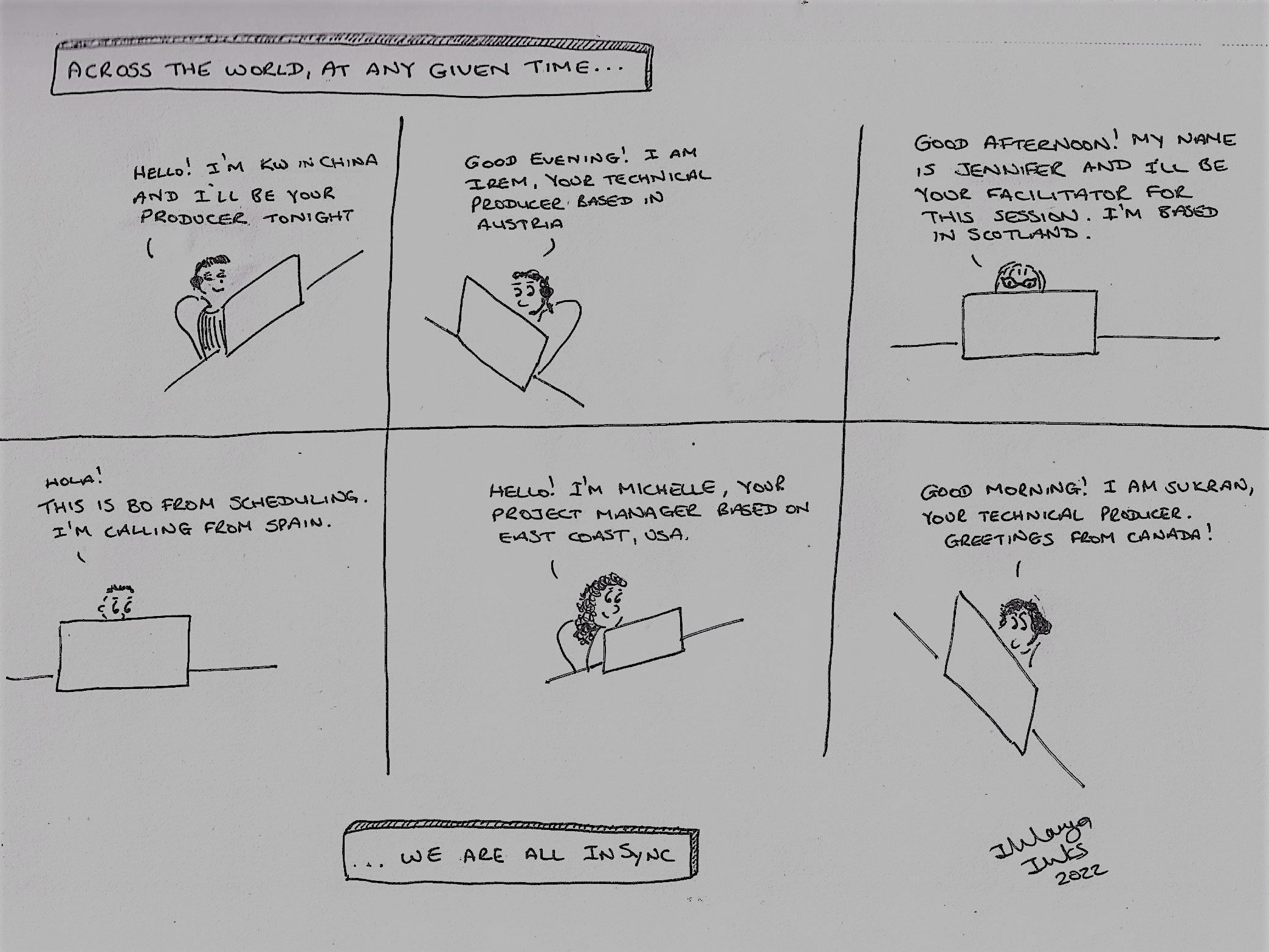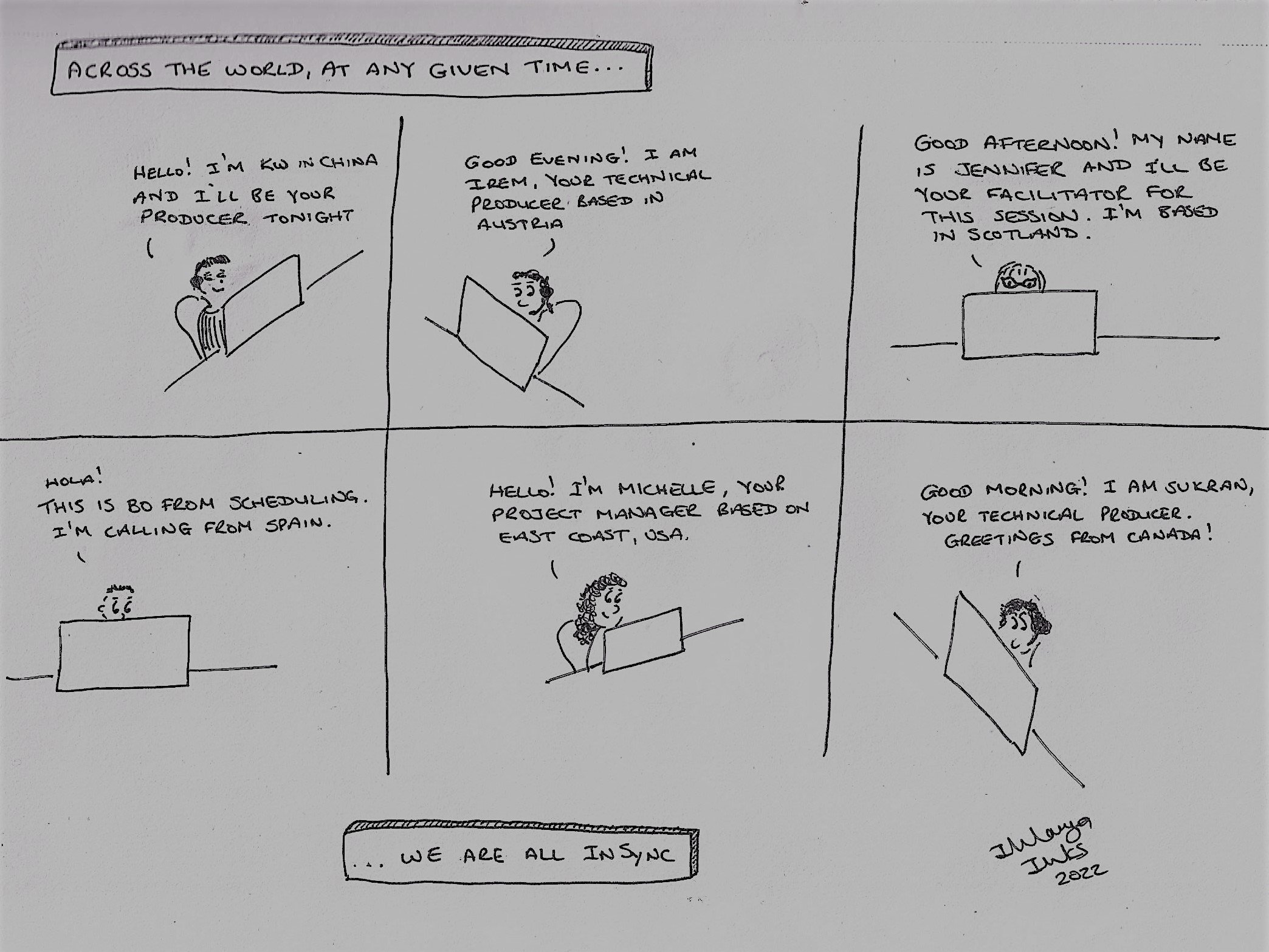It Was Almost Like Being in a Real Class! Making Virtual Learning Real
Jennifer Hofmann often states that the focus of virtual learning should be fundamentally on the learners, their experiences and their learning...

Looking for insight into the daily routine of a new virtual facilitator? The following events at an internal training department are based on real facts. Names have been changed to protect the innocent - and my job.
Monday
4:00 p.m.
I'm ready to go home, but I need to prepare for tomorrow's virtual training workshop. I check my tools and supplies and make certain that the equipment is in working order.
5:00 p.m.
I send an email to Producer Anne to verify our rehearsal at 10 a.m. the following morning. With that chore done, I go home feeling confident. I'm prepared, and--barring any major catastrophe--the class tomorrow should proceed as planned.
8:00 p.m.
At home I decide to log into email, and I'm glad I do. A message from Anne says that we need to shorten our prep from 90 minutes to 30 minutes because of a change in another virtual class. There are also messages from two learners who need to reschedule their class. Next, I try to log onto the learning server to review the content, but the server is down. The Chat and Help Desk functions are not available because it's so late, so I guess I'll call it a night.

Tuesday
7:00 a.m.
I arrive at work early to review the content that I couldn't access last night. Unfortunately, the server is still down. I tell myself not to worry and check my email, which has messages from three participants who didn't realize that they needed to complete prework. I quickly send an email, informing them that the prework is a required part of the course.
7:30 a.m.
I call the company's IT Help Desk about the learning server problem but receive little help. The person answering calls tells me that he doesn't manage that server any longer and that a memo explaining the new changes is scheduled to go out to all staff next week. I learn that I should call someone named Steve at 9 a.m. I jot down the new number and, again, tell myself not to panic.
7:50 a.m.
Time for a break. I go to the cafeteria for tea and coffee cake. I promise myself that I'll have a relaxing and healthy lunch. I need to maintain my energy during the class. Walking back to my office, I run into my boss, Sam. She asks me to join a two o'clock meeting to discuss the importance of virtual training within the organization. When I explain that I'm facilitating a virtual class until 3:00 p.m., she asks me to reschedule the session until tomorrow.
While I tell her that it's impossible to reschedule the course, inside I'm thinking, "Now I know how important she considers virtual training to be." We agree to meet at 3:30--after the class.
8:00 a.m.
I spend this downtime reviewing content and rehearsing the class.
9:00 a.m.
I call Steve, the new server administrator, at 9:00 a.m. on the dot. We arrange to reboot the learning server. Steve stays on the phone with me while we check that everything is working correctly. I make a note to myself to send Steve Thank You and Welcome notes. I've found that it's a good idea to keep the IT folks on my side!
9:15 a.m.
Because I was working with Steve on the server, I arrive late to a department meeting. While I was gone, my co-workers discussed who should be in charge of all virtual training. Congratulations, I've been elected.
One good thing--at least, I think it's a good thing--Sam asks to sit in on today's class. But first, I'll need to set up her machine.
10:10 a.m.
Anne and I start rehearsal 10 minutes late. Because Anne can only stay until 10:30, we review the important interactions and I promise to send her an updated roster before 1:00 p.m. I hope everything works as planned – otherwise we will not be able to maintain engagement throughout the program.
10:30 a.m.
I install the learning software and test Sam's machine, procure a headset, and provide a tutorial on the user interface.
11:15 a.m.
Back at my desk, I read an email from a learner. Natalie is trying to complete the prework, but she can't get the eLearning module to work. I call right away and walk her through the steps for downloading the appropriate plug-in.
While we're on the phone, I get a message from John, who has decided to participate in the course from home and needs help installing the software. I email him instructions and call to confirm receipt. On the phone, I ask him about his computer. He shares he will be using his iPad. I explain that virtual classroom features work very differently on mobile devices and I won’t be able to help him technically. He says not to worry – his son will help him. But, I realize this is the new reality. I probably should have anticipated this.
12:00 p.m.
Lunch. So much for a healthy and relaxing meal. I grab a diet soda, a donut, and the leader guide to get in some last-minute prep work. I vow to improve my eating habits--later. I also get a couple of bottles of water for later and head for the classroom, where I hang a "Do Not Disturb--Class in Session" sign on the door.
12:30 p.m.
The class officially starts at 1:00 p.m., but I ask participants to log on 15 minutes early. I log on at 12:30 and start to set up the exercises. Anne is already logged on, so I tell her that I've just sent her the final roster and phone list via email.
12:35 p.m.
The phone rings. Caller ID indicates that it's John. I hope he's calling for his technical check and not because there's a problem. I ask Anne to stay online to greet participants as they enter the classroom. John tells me that he hasn't found a headset, but he does have working speakers built into his machine. Because John can’t figure out how to make the microphone work, I tell him to use the chat feature to communicate with the class. Then, I send a chat note to Anne with the update.
12:40 p.m.
Ignoring the "Do Not Disturb" sign, my co-worker Matt enters the room. Because I'm the new project lead, he wants me to clear up a few issues. When I tell Matt that this isn't a good time and point out the "Do Not Disturb" sign, he says he didn't think that I would mind him coming in. I try not to sound annoyed when I schedule a meeting with him for the next day. Then I lock the door behind him.
12:45 p.m.
Time to focus. Anne is working with participants as they log on. She greets them and asks: "Do you have your participant workbook with you? If not, please go and get it now." "Let's do an audio-check." "Did you complete your prework? If not, then you should consider attending next week's class." Anne troubleshoots an audio problem--the microphone is plugged into the wrong hole--and arranges for one participant to attend next week's program.
12:55 p.m.
Out of the 11 scheduled participants, including my boss Sam, only 8 arrive. One of the learners who cancelled yesterday has also shown up because his schedule changed. Anne steps out of class to contact the missing participants. She sends a chat note indicating that she can't locate Sam and leaves messages with the others to call or sign in as soon as possible.
In addition to the person logging in from the iPad, two of the participants are together learning together on a projection screen. Three are working from the office and two are at home. Welcome to the new world of hybrid virtual learning! This is going to be more complicated than I thought. I internally make adjustments to the activities to ensure that environmental engagement is maximized for all learners and make a note to ask the designers for advice next time.
1:00 p.m.
It's show time! I start the recording feature, and class begins. Other than Anne being kicked off the server for a few minutes, the first hour goes very well. Everyone has completed their prework and is participating, except John. During a reading assignment I check in and remind him to use the chat or hand feature to communicate.
1:45 p.m.
Judy logs in 45 minutes late, explaining that she was confused because she works in the Central time zone and the class was listed in Eastern standard time. I send her to the breakout room to work with Anne before she can participate.
1:50 p.m.
Time for a 10-minute break; at least for the participants. Anne and I spend the break working with Judy. Finally, Sam logs in and apologizes for being late.
2:00 p.m.
The last hour of class proceeds well, and only two people need to leave early. One of which is Sam, of course.
3:00 p.m.
Class is completed, and on time for once! At a quick glance, the chat comments, feedback and quiz results look good. I make a note to add Anne's name to my list of Thank You notes. Then I test the recording before publishing it to the server. The recording looks okay, so I send a note to the class advertising it and thanking them for their attendance and participation.
One last chore: I access the LMS and enroll the missing learners in next week's class. Finally, I log out of the classroom.
3:20 p.m.
I take advantage of the locked office to close my eyes for 10 minutes. When I look up, 20 minutes have passed.
3:45 p.m.
I'm 15 minutes late for my meeting with Sam, who asks if I could start to teach three classes a day because each class is only two hours in length. Rather than laugh in her face, I tell her that, theoretically, I could facilitate two courses each day, but I would need technical and administrative support. Sam looks doubtful, but asks me to compile some suggestions for her by the end of the week.
4:00 p.m.
Time to go home. As I gather up my things, I spot Matt and remind him of our meeting the next day. He comments that teaching online must be a cushy assignment since I get to leave early and don't have to travel. I just smile and tell him that he'll have the chance to experience it for himself very soon.
Interested in learning more about becoming a virtual facilitator? Check out Virtual Classroom Facilitation Mastery Series to earn your Virtual Classroom Facilitator Certificate Badge.

Jennifer Hofmann often states that the focus of virtual learning should be fundamentally on the learners, their experiences and their learning...

1 min read
One of the key qualities of anyone involved in L&D is having an analytical mindset. It is crucial for the continuous improvement of learning...

As organizations increasingly rely on virtual classrooms to upskill and reskill their teams, the role of the virtual facilitator has become a...